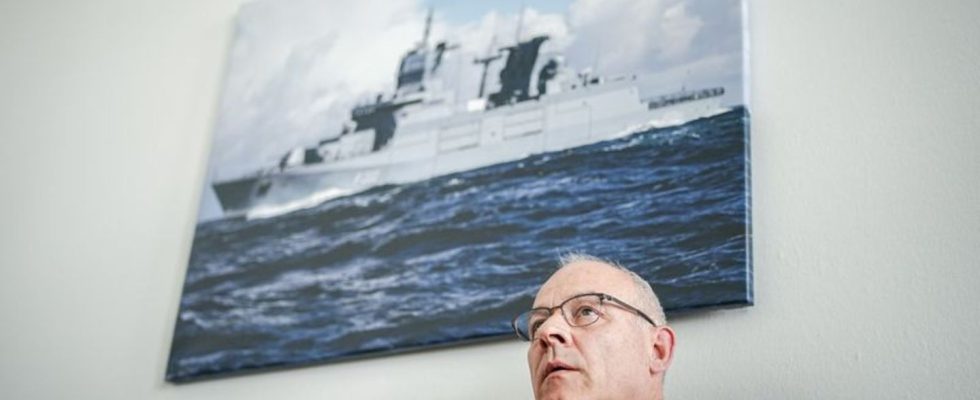The Navy chief warns against hesitation in modernizing the German naval forces. He points to a changed security situation and important tasks for which new ships are necessary.
Marine inspector Jan Christian Kaack is calling for an order for two more frigates for the naval forces and warns of the risk of cost increases. “I think it is absolutely necessary that Germany takes this option and orders these two frigates. And I agree with the minister on this, because we must now invest in the fleet of the future so that we can continue to fulfill our tasks of protecting our people in the long term can guarantee,” the vice admiral told the German Press Agency in Berlin. Kaack also referred to a changing security situation and the importance of the German navy for protecting critical infrastructure.
Kaack made the comments ahead of the expected return of the frigate “Hessen” from the EU mission “Aspides” in the Red Sea in Wilhelmshaven tomorrow, Sunday. The task force supplier “Frankfurt am Main” and the frigate “Baden-Württemberg” are also scheduled to leave for the Indo-Pacific on Tuesday.
Construction of the first F126 class frigate began in December. The Bundeswehr is planning to build ships that will be “capable of three-dimensional naval warfare worldwide and comprehensively.” This means that targets can be fought underwater, on the water and in the air. Maritime surveillance, enforcing embargoes, supporting special forces and evacuation operations are named as the most important tasks.
Operational and financial reasons for ordering additional frigates
Four frigates are financed and there is an option for two more ships at a similar price. “Any delay or non-use of this option would lead to an increase in costs when ordering later,” warned Kaack. The two additional ships are operationally necessary in view of the expected threats in the next few years. He demanded: “We need highly effective combat units that can assert themselves in combat, and in numbers that we can also ensure that we can use them permanently.”
He refers to the “mathematics of the Navy”, in which operational readiness and repair processes are thought of in a variety of three ways: one ship ready for combat, one on the way to combat readiness and one in the process of repair. “In this respect, a number of six Class 126 frigates is something where we can sustainably and assertively secure Germany’s missions in the North Atlantic, in the long-range submarine hunt of nuclear submarines, but also in the protection of critical maritime infrastructure – also worldwide.”
The Navy sees increasing efforts by the Russian naval forces to scout critical maritime infrastructure – pipelines, communication lines and energy supply lines. Kaack said: “They take a very close look at where things are and also look at where there might be weak points. But then they also realize that we notice it and that we kill it straight away,” said Kaack. At the same time, he certified that the Russian Navy behaved absolutely normally when it encountered at sea, in which well-rehearsed procedures were observed.
Look closely: deterrence through “attributability”
In September 2022, the blowing up of the North Stream pipelines in the Baltic Sea alarmed politicians and security experts, without the perpetrator being identified. Increased efforts to protect such facilities have begun, but they are not easy; in some cases, responsibilities and procedures are also being put to the test.
“For me, the motto is deterrence through attribution. If the opponent knows that we know that he is acting there, it is less likely that he will do something,” said Kaack. The prerequisite for this is an evaluated above- and underwater situation picture, the combination of sensor information and data. There are projects for this. He mentions “From Seabed to Space”, which brings together information from civil and military satellites in order to evaluate abnormalities in ship movements – especially when automated information systems for the location are switched off. Artificial intelligence is also used.
NATO has set up its own office for such tasks and six European states, including Germany, Denmark and Great Britain, want to work together to better protect the infrastructure in the North Sea. In addition, Germany has offered NATO to run a regional maritime headquarters for the Baltic Sea, meaning it will soon assume so-called spatial responsibility for the important maritime area.
Construction sites also remain in Germany
Kaack is convinced that attacks such as those on the infrastructure would continue to take place in a gray area in the future so as not to trigger a defense or alliance situation. Therefore, responsibilities and procedures should be put to the test.
“I would always think from behind: What kind of effect do I want to achieve,” says Kaack. “If you now ask in the various departments, you will be told that the responsibilities are regulated. Within the territorial waters the water police, beyond that in the exclusive economic zone the federal police and if something “pops”, so to speak, the navy. To what extent the current responsible people However, there are opportunities to have an impact, that needs to be questioned.”
The Navy therefore advocated in a departmental working group to focus on specific scenarios and the processes that would then take effect. “And who ultimately decides that we can actively combat a recognized threat from an enemy within our territorial waters. So similar to the Aviation Security Act,” said the inspector. And: “The discussion is being held. It must also be held.”

